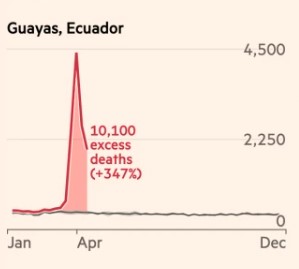Insight
Increasingly, the best way to measure the toll of Covid19 around the world is not the reported deaths (such as from Our World in Data) but by looking at overall deaths in a population. As an example, the reported deaths to 27 April 2020 in the UK are 20,732, but based on population mortality in England and Wales, UK actuaries estimate between 41,000 and 48,000 deaths to 27 April 2020.
This week’s release of data on deaths in England and Wales is worse than expected, and that was quite bad. The Actuaries Continuous Mortality Investigation has analysed the deaths in England and Wales up to 17 April 2019.
Our analysis suggests that:
- there could have been in the range of 38,000 to 45,000 cumulative excess registered deaths in England
& Wales by 27 April 2020; and- applying the same method to the PHE figure for UK deaths suggests 41,000 to 48,000 excess registered
deaths in the UK.

This type of excess death analysis is increasingly being done by international media sources – a good example is The Financial Times, which shows examples from around the world, including Guayas, in Ecuador, shown here. It has a population of around 3.5 million (around 20% of the Ecuadorian population). The official Covid19 statistics for Ecuador show 663 deaths for the whole country, but regional death statistics show a horrifying spike in deaths in the last month, of around 10,000 excess deaths in the province of Guayas alone.
Link
For those who have been interested in my recent school posts, Karen posted an interesting summary of the paediatric literature on Covid19. It is a constantly updated review of studies around the world on all aspects of Covid19 in children.
Following the initial epidemiological data released from China, it appeared children were significantly less affected by infection with SARS-CoV-2 than their adult counterparts. This was reflected both in total case numbers, but also severity, with very few cases in young children and no deaths in children under 10yrs in the initial report. This finding has been reproduced in subsequent data from other countries, most notably Italy, which showed much lower rates of infection in children and no deaths in those under 30 years of age. Low numbers of childhood cases have been seen in the rest of Europe, as well as the USA, where 1/3 of childhood cases are in late adolescence. Some concerns exist that low case rates reflect selective testing of only the most unwell, however data from South Korea and subsequently Iceland which have undertaken widespread community testing, have also demonstrated significantly lower case numbers in children. This has also been seen in the Italian town of Vo, which screening 70% of its population and found 0 children <10 years positive, despite a 2.6% positive rate in the general population.
Life Glimpses
Here in NSW, the plan is for public schools to gradually return to normal from 11th May (which is a week and a half from now – the third week of the second term of the year). The government has left it up to schools, with the request that at the beginning, there will only be 25% of the school students there at any one time. Our school has decided to take the Year 12s back full time, with all the other students going back for one day per week (in year groups). I must admit to being fairly sceptical about whether our government school has been given enough resources to make the school as hygienic as it should be in a pandemic – a school teacher friend of mine was exclaiming about how dirty most schools are most of the time.
My sense is that the students are all looking forward to being back at school, and seeing their friends, but at the same time, they know enough about what is going on to be worried about whether it is actually possible to be at school, and keep appropriately distanced from their friends and teachers.
Bit of beauty
Today’s bit of beauty is a flower from the lane at the end of our street – not the most scenic spot, being next to a petrol station, but you can find beauty in the most unexpected of places.


Yesterday I looked at the number of deaths in children in NYC, Italy, Spain, UK and Germany. Of a total of almost 75,000 recorded deaths, only 12 were in respect of children. Astoundingly low.
Wow that is lower than I thought, given I have read whole articles on two of them. I have always thought the risk from reopening schools was to the community (and teachers) not the students, but it is even less than I thought.
I do not remember if I commented on this beautiful flower. What one needs are open eyes.
There are discussions if and when to open schools, what ages etc.